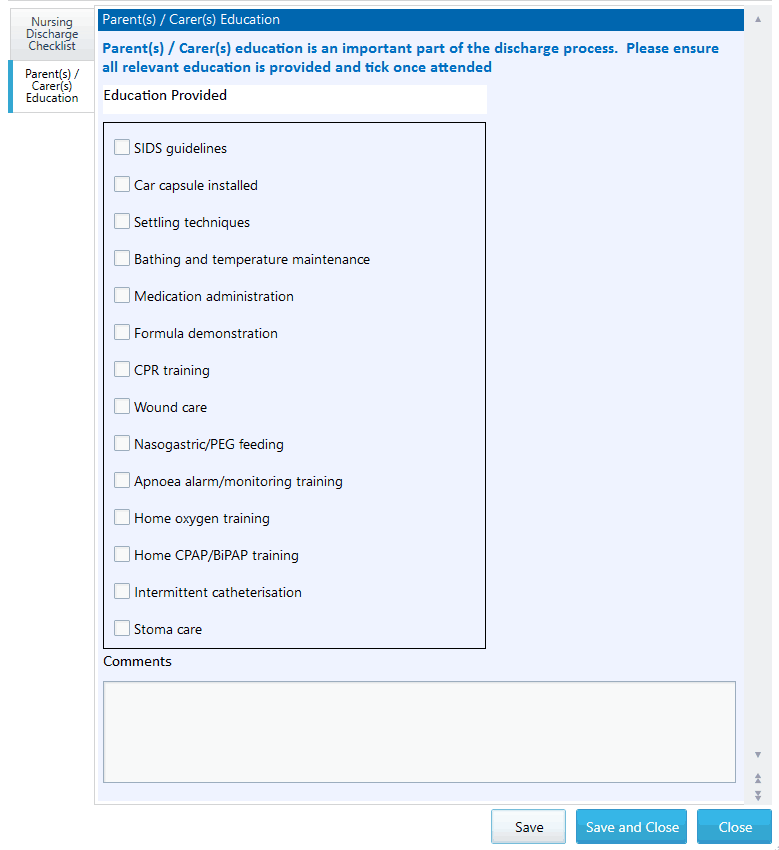
Transition

Families and carers want to be involved in discharge planning and share their own needs or preferences. Transitions between services and environments can make them feel vulnerable, so clear communication and support is important.
At the handover stage, staff in the unit should ensure that the family or carer:
- is present at handover
- participates in handover by contributing information and shared goals
- has an opportunity to ask questions
- receives complete and accurate information
- is asked for observations about their baby.
For more, see Communicating with families and carers and Handover.
 Parents say
Parents say
“I had missed rounds that morning, and another parent runs up to me and says 'Oh, they're sending Liam home tomorrow!”
“His transfer plan was to St George Hospital. But I stepped up and said ‘Actually, Sutherland is closer, a five-minute drive from home so I’d rather he go there if appropriate.’”
“If we had the opportunity for more discussions involving the parents in the process, there probably wouldn’t have been such a misunderstanding.”
Family and carer education
Parent/carer education is an important part of the discharge process. Make sure you use the relevant discharge education checklists, including the Parent/Carer Education Checklist in the Electronic Record for Intensive Care (eRIC).
Show discharge education checklists
Following resources available:
- SIDS guidelines
- Car capsule installed
- Settling techniques
- Bathing and temperature maintenance
- Medication administration
- Formula demonstration
- CPR training
- Wound care
- Nasogastric/PEG feeding
- Apnoea alarm/monitoring training
- Home oxygen training
- Home CPAP/BiPAP training
- Intermittent catheterisation
- Stoma care

Education sessions that will prepare the family to care for the child at home can also be run virtually, e.g. safe sleeping practices. Grandparents or friends can be included in these sessions, providing support for the parents and carers.
Information on definition, link to NSW Policy on Clinical Handover and involvement of patients.
Source: Clinical Excellence Commission
Safety fundamentals for person-centred communication
Summary for supporting healthcare staff in building partnerships with patients to provide safe, respectful and reliable care
Source: Clinical Excellence Commission
Going home from hospital: sick or premature babies
Information for parents and families on what to expect and tips on managing the transition from hospital to home.
Source: Clinical Excellence Commission
Information for parents and families on what happens after the hospital.
Source: Miracle Babies Foundation
Nurture Program services and resources
Links to in-person and virtual support for families after you leave hospital.
Source: Miracle Babies Foundation
 Staff say
Staff say
“Include parents in the transfer of care process. They often point out important information that may have been missed.”
“The more you involve the parents and carers in what is happening, the more comfortable they are in transferring to different levels of care.”
Using virtual care
Virtual care can be used to make transition as smooth as possible for families and carers.
Videoconferencing allows families, carers and other healthcare professionals to join discharge planning sessions and make collaborative decisions
This may also include the baby’s pediatrician, child and family health nurse, family GP or other providers engaged in patient care.
Providing a virtual orientation option (in addition to or as an alternative to in-person) to the new location if families and carers are offsite will also support the parent and carer transition.
Use a smartphone or tablet to hold a videoconference, conduct a clinical handover, connect the family and carers with the new clinical team and provide a tour of the facility and answer any questions the family may have.
See Virtual Care for resources, including step-by-step instructions on making calls.